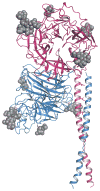Henipavirus outbreaks to antivirals: the current status of potential therapeutics
- PMID: 22482714
- PMCID: PMC4347837
- DOI: 10.1016/j.coviro.2012.02.016
Henipavirus outbreaks to antivirals: the current status of potential therapeutics
Abstract
The henipaviruses, Hendra virus and Nipah virus, are classic examples of recently emerged viral zoonoses. In a relatively short time since their discoveries in the mid and late 1990s, respectively, a great deal of new information has been accumulated detailing their biology and certain unique characteristics. Their broad species tropism and abilities to cause severe and often fatal respiratory and/or neurologic disease in both animals and humans has sparked considerable interest in developing effective antiviral strategies to prevent or treat henipavirus infection and disease. Here, recent findings on the few most advanced henipavirus countermeasures are summarized and discussed.
Published by Elsevier B.V.
Conflict of interest statement
The author is a United States federal employee and coinventor on patents relating to human monoclonal antibodies against Hendra and Nipah viruses, soluble forms of Hendra and Nipah envelope glycoproteins and vaccines and peptide-based fusion inhibitors targeting henipaviruses; assignees are The United States of America as represented by the Department of Health and Human Services (Washington, DC), and the Henry M. Jackson Foundation for the Advancement of Military Medicine, Inc. (Bethesda, MD).
Figures


References
-
- Chua KB. Nipah virus outbreak in Malaysia. J Clin Virol. 2003;26:265–275. - PubMed
-
- Eaton BT, Mackenzie JS, Wang L-F. Henipaviruses. In: Knipe DM, Howley PM, editors. Fields Virology. 5. Vol. 2 Lippincott Williams & Wilkins; 2007. pp. 1587–1600.
-
- Bishop KA, Broder CC. Hendra and Nipah: Lethal Zoonotic Paramyxoviruses. In: Scheld WM, Hammer SM, Hughes JM, editors. Emerging Infections. American Society for Microbiology; 2008. pp. 155–187.
Publication types
MeSH terms
Substances
Grants and funding
LinkOut - more resources
Full Text Sources

